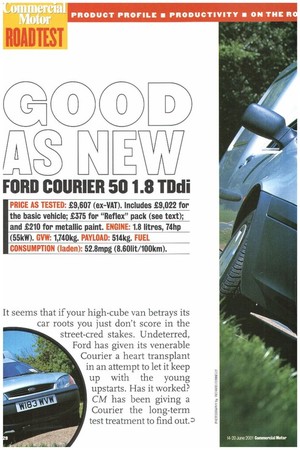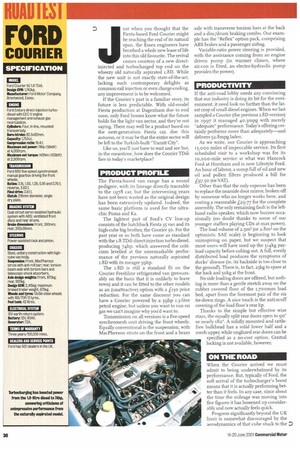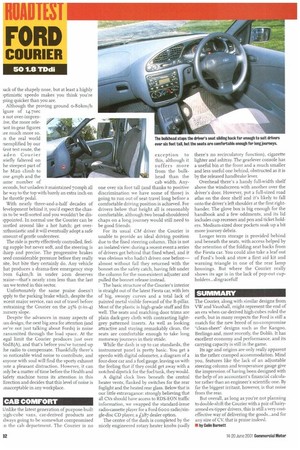FORD COURIER 501.8 TDdi
Page 28

Page 30

Page 32

If you've noticed an error in this article please click here to report it so we can fix it.
IPRICE AS TESTED: £9,607 (ex-VAT). Includes £9,022 for the basic vehicle; £375 for "Reflex" pack (see text); and £210 for metallic paint. ENGINE: 1.8 litres, 74hp (55kW). GVW: 1,740kg. PAYLOAD: 514kg. FUEL CONSUMPTION (laden): 52.8mpg (8.601it/100km).
It seems that if your high-cube van betrays its car roots you just don't score in the street-cred stakes. Undeterred, Ford has given its venerable Courier a heart transplant in an attempt to let it keep up with the young upstarts. Has it worked? CM has been giving a Courier the long-term test treatment to find out.
ust when you thought that the Fiesta-based Ford Courier might be reaching the end of its natural span, the Essex engineers have breathed a whole new lease of life into this old favourite. The revival comes courtesy of a new direct injected and turbocharged top end on the wheezy old naturally aspirated 1.8D. While the new unit is not exactly state-of-the-art, lacking such contemporary delights as common-rail injection or even charge-cooling, any improvement is to be welcomed.
If the Courier's past is a familiar story, its future is less predictable. With old-model Fiesta production at Dagenham due to end soon, only Ford bosses know what the future holds for the light van sector, and they're not saying. There may well be a product based on the next-generation Fiesta car, due this autumn, or it may be that the entire sector will be left to the Turkish-built "Transit City".
Like us, you'll just have to wait and see but, in the meantime, how does the Courier TDdi fare in today's marketplace?
PRODUCT PROFILE
The Fiesta-based van range has a sound pedigree, with its lineage directly traceable to the 1978 car, but the intervening years have not been wasted as the original design has been extensively updated. Indeed, the same basic platform is used for the ultrachic Puma and Ka.
The lightest part of Ford's CV line-up consists of the hatchback Fiesta 35 van and its high-cube big brother, the Courier 50. For the past year or so both have come as standard with the 1.8 TDdi direct-injection turbo-diesel, producing 74hp, which answered the criticism levelled at the unremarkable performance of the previous naturally aspirated 1.8D with its meagre 59hp.
The 1.8D is still a standard fit on the Courier Freshline refrigerated van (presumably on the basis that it is unlikely to leave town) and it can be fitted to the other models as an (unattractive) option with a £130 price reduction. For the same discount you can have a Courier powered by a 59hp 1.3-litre petrol engine, but unless you want to run on gas we can't imagine why you'd want to.
Transmission on all versions is a five-speed synchromesh unit driving the front wheels. Equally conventional is the suspension, with MacPherson struts on the front and a beam axle with transverse torsion bars at the back and a disc/drum braking combo. Our example has the "Reflex" option pack, comprising ABS brakes and a passenger airbag.
Variable-ratio power steering is provided. with the assistance coming from an engine driven pump (in warmer climes, where air-con is fitted, an electro-hydraulic pump provides the power).
PRODUCTIVITY
If the anti-road lobby needs any convincing that our industry is doing its bit for the environment, it need look no further than the latest crop of small diesel engines. When we last sampled a Courier (the previous 1.8D version) in 1997 it managed 4o.3mpg with merely "adequate" performance. Today's offering certainly performs more than adequately—and delivers 52.8mpg laden.
As we write, our Courier is approaching 13,000 miles of impeccable service. Its first scheduled visit to a workshop was for its io,000-mile service at what was Hancock Ford at Horsham and is now Lifestyle Ford. An hour of labour, a sump full of oil and new oil and pollen filters produced a bill for 197.50 (ex-VAT).
Other than that the only expense has been to replace the nearside door mirror, broken off by someone who no longer works here, and costing a reasonable £29.77 for the complete assembly. The only remaining fault is the lefthand radio speaker, which now buzzes occasionally (no doubt thanks to some of our younger staffers playing CDs at max power).
The load volume of 2.5m3 (or 2.8m3 on the optimistic SAE scale) is beginning to look uninspiring on paper, but we suspect that most users will have used up the 514kg payload capacity before cubing out. A full, evenly distributed load produces the symptoms of ducks' disease (ie, its backside is too close to the ground!). There is, in fact, 25kg to spare at the back and 50kg at the front.
No side loading doors are offered, but nothing is more than a gentle stretch away on the rubber covered floor of the 1,700mm load bed, apart from the foremost pair of the six tie-down rings. A nice touch is the anti-scuff covering of the load floor's rear lip.
Thanks to the simple but effective wire stays, the equally split rear doors open to 90° or nearly 58e. A solidly mounted and rattlefree bulkhead has a solid lower half and a mesh upper, while unglazed rear doors can be specified as a no-cost option. Central locking is not available, however.
ON THE ROAD
When the Courier arrived we must admit to being underwhelmed by its performance. But, typically of Ford, the soft arrival of the turbocharger's boost means that it is actually performing better than it feels. In any case, since about the time the mileage was moving into five figures it has loosened up considerably and now actually feels quick.
Progress significantly beyond the UK limit is somewhat discouraged by the aerodynamics of that cube stuck to the 0
)ack of the shapely nose, but at least a highly ptimistic speedo makes you think you're ;oing quicker than you are.
Although the proving ground o-Sokrn/h igure of 14.7sec s not over-impresive, the more rele-ant in-gear figures ;re much more so. n the real world !xemplified by our (ent test route, the aden Courier )riefly faltered on he steepest part of he M2o climb to ose 4mph and the ;ame number of ;econds, but unladen it maintained 70mph all he way to the top with barely an extra inch on he throttle pedal.
With nearly three-and-a-half decades of ievelopment behind it, you'd expect the chasds to be well-sorted and you wouldn't be disippointed. In normal use the Courier can be iustled around like a hot hatch: get overmthusiastic and it will eventually adopt a safe 'mount of gentle understeer.
The ride is pretty effectively controlled, teeing supple but never soft, and the steering is ;harp and precise. The progressive brakes ieed considerable pressure before they really )ite, but bite they certainly do. Any vehicle hat produces a drama-free emergency stop 'rom 64krn/h in under zom deserves raise—that's nearly iom less than the last ran we tested in this sector.
Unfortunately the same praise doesn't ipply to the parking brake which, despite the -ecent major service, ran out of travel before :estraining the Courier on the 25% (r-in-4) aursery slope.
Despite the advances in many aspects of san design, the next big area for attention (and ue're not just talking about Fords) is noise .ransrnitted through the load space. At the egal limit the Courier produces just over SodB(A), and that's before you've turned up :he radio to compensate. Thankfully there's io noticeable wind noise to contribute, and inyone with soul will Grid the sporty exhaust aote a pleasant distraction. However, it can )nly be a matter of time before the Health and safety machine turns its attention in this iirection and decides that this level of noise is macceptable in any workplace.
CAB COMFORT
Unlike the latest generation of purpose-built ligh-cube vans, car-derived products are ilways going to be somewhat compromised .n the cab department. The Courier is no
exception to this, although it suffers more from the bulkhead than the cab width. Anyone over six foot tall (and thanks to positive discrimination we have some of those) is going to run out of seat travel long before a comfortable driving position is achieved. For drivers below that height all is reasonably comfortable, although two broad-shouldered chaps on a long journey would still need to be good friends.
For its usual CM driver the Courier is unable to provide an ideal driving position due to the fixed steering column. This is not an isolated view: during a recent event a series of drivers got behind that fixed wheel, and it was obvious who hadn't driven one before— almost without fail they returned with the bonnet on the safety catch, having felt under the column for the non-existent adjuster and pulled the bonnet release instead.
The basic structure of the Courier's interior is straight out of the latest Fiesta car, with lots of big, swoopy curves and a total lack of painted metal visible forward of the B-pillar. Most of the plastic is high-grade stuff and fits well. The seats and matching door trims are plain dark-grey cloth with contrasting lightgrey patterned inserts. As well as looking attractive and staying remarkably clean, the seats are comfortable enough to take long motorway journeys in their stride.
While the dash is up to car standards, the instrument panel is pretty basic. You get a speedo with digital odometer, a diagram of a four-door car and a fuel gauge, leaving us with the feeling that if they could get away with a notched dipstick for the fuel tank, they would.
A digital clock lives beneath the central heater vents, flanked by switches for the rear foglight and the heated rear glass. Below that is our little extravagance: strongly believing that all CVs should have access to RDS-EON traffic information, we swapped the standard-issue radio-cassette player for a Ford 6000 radio/single-disc CD player, a £287 dealer option.
The centre of the dash is completed by the nicely engineered rotary heater knobs (sadly there's no recirculatory function), cigarette lighter and ashtray. The gearlever console has a useful bin at the front and a much smaller and less useful one behind, obstructed as it is by the released handbrake lever.
Overhead there's a handy full-width shelf above the windscreen with another over the driver's door. However, put a full-sized road atlas on the door shelf and it's likely to fall onto the driver's left shoulder at the first tight. bander. The glove box is big enough for the handbook and a few oddments, and its lid includes cup recesses and pen and ticket holders. Medium-sized door pockets soak up a bit more journey debris.
Longer term storage is provided behind and beneath the seats, with access helped by the retention of the folding seat backs from the Fiesta car. You could also take a leaf out of Ford's book and stow a first aid kit and warning triangle in one of the rear lamp housings. But where the Courier really shows its age is in the lack of pop-out cupholders ... dis graceful!
SUMMARY
The Courier, along with similar designs from VW and Vauxhall, might represent the end of an era when car-derived high-cubes ruled the earth, but in many respects the Ford is still a match for the new breed of no-compromise "clean-sheet" designs such as the Kangoo, Berlingo and, most recently, the Doblii, It has excellent economy and performance, and its carrying capacity is still in the game.
Its age and origins are only really apparent in the rather cramped accommodation. Mind you, features like the lack of an adjustable steering column and temperature gauge give the impression of having been designed with the help of an accountant's financial calculator rather than an engineer's scientific one. By far the biggest irritant, however, is that noise from the rear.
But overall, as long as you're not planning to double-shift the Courier with a pair of hairyarmed ex-tipper drivers, this is still a very costeffective way of delivering the goods...and for any size of CV, that is praise indeed.
• by Cohn Barnett
































































































